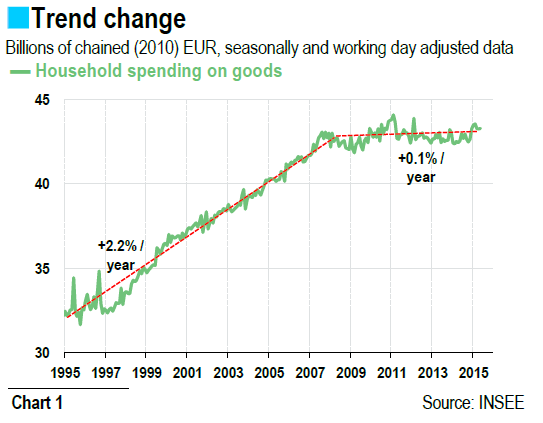Household spending on goods picked up very slightly in May (+0.1% m/m in real terms), contrary to an expected decline based on the contraction in new car registrations (-1.5% m/m). Actually, automobile purchases increased slightly during the month, as did spending on energy and purchases of other goods. In contrast, spending on household furnishings and clothing declined slightly. On a year-on-year basis, excluding energy expenditures, all components of consumption show a rise, albeit not a very buoyant one (see table).
This marginal gain in May follows April’s stagnation and a significant decline in March (-0.6% m/m), hence the negative carry-over for Q2 (-0.4%). This sluggishness comes as a payback after vigorous Q1 growth (1.5% q/q). At the time, household consumption benefited from two temporary support factors: the rebound in energy consumption (after temperatures fell back to more seasonal norms) and the purchasing power gains arising from the sharp drop in oil prices, which boosted the other spending components. Lower oil prices had a favourable impact on household confidence, notably on their assessment of the opportunity for making big-ticket purchases, which is reflected in the statistics. However, with no further decline in oil prices since February, and without any support yet from the job market, it is normal to observe a marked slowdown in Q2 consumption. Moreover, a decline in consumer spending on goods does not necessarily foreshadow a decline in total household consumption. Indeed, household spending is divided into more or less equal parts between goods and services. The increase in spending on services tends to be much more stable and rarely negative, offsetting the ups and downs of spending on goods. We expect household consumption to increase 0.1% q/q in Q2, while the INSEE is forecasting an increase of 0.2%.

Once past this backlash, household consumption should regain some momentum (about 0.3% q/q per quarter), in line with the mild upturn in the purchasing power of gross disposable income. For the moment, its uptrend is mainly due to disinflation and smaller tax increases, but as of mid-2015, the job market is expected to pick up slightly, which should provide further support. Thanks to the very strong Q1, household consumption is expected to rebound strongly in full-year 2015 (growth is forecast at 1.8%, vs 0.5% in 2013 and 0.6% in 2014). In 2016, household consumption is not expected to increase as much (+1.1%), since purchasing power gains will diminish due to slightly higher inflation. That is better than the near stagnation observed since 2008, which marked a clear break with the previous trend (see chart). Yet 1.1% is still far below the average pace of increase in household consumption observed up until 2007, which was slightly higher than 2% a year. Consumption is therefore likely to surprise on the upside, and growth as well. Granted, growth is hampered by the strong headwinds inherited from the clean-up of past excesses and by the structural weaknesses of the French economy. But in so far as these headwinds are rather dissipating and reforms have been launched to address structural problems, it is also plausible that growth will end up finding a second wind.

by Hélène BAUDCHON
